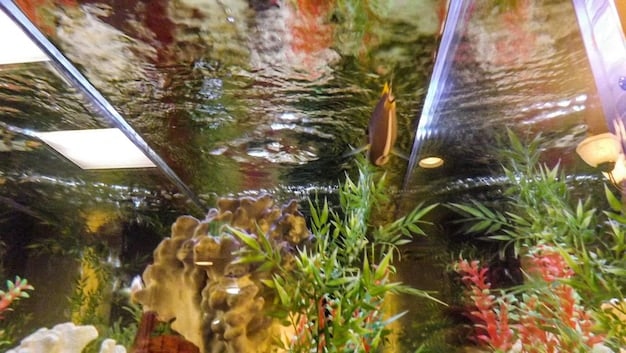Environmental Enrichment: Impacting Animal Welfare & Quality of Life

Environmental enrichment significantly enhances animal welfare by providing stimulating environments that cater to their physical and psychological needs, improving their overall quality of life.
The concept of environmental enrichment is revolutionizing how we care for animals, moving beyond basic needs to focus on improving their psychological and physical well-being, leading to a better quality of life.
Understanding Environmental Enrichment
Environmental enrichment involves modifying an animal’s living environment to enhance its behavioral opportunities and promote psychological well-being. It’s about creating an environment that meets their specific needs, stimulating natural behaviors and mitigating stress.
What is Environmental Enrichment?
Environmental enrichment encompasses a variety of techniques and strategies designed to enhance the quality of life of animals in captivity or under human care. This could include anything from toys and puzzles to social groupings and naturalistic habitats.
The overarching goal is to provide opportunities for animals to engage in species-typical behaviors, exercise cognitive abilities, and maintain physical health. By catering to an animal’s intrinsic needs, environmental enrichment helps reduce stress, boredom, and the development of abnormal behaviors.
Why is Environmental Enrichment Important?
The importance of this is rooted in the understanding that animals, like humans, have psychological and emotional needs that must be met for optimal well-being. When these needs are ignored, animals can experience a decline in their mental and physical health.
- Mitigates Stress: A stimulating environment reduces stress levels.
- Encourages natural behaviors: Provides opportunities for animals to engage in species-typical activities.
- Improves Psychological Well-being: Boosts cognitive function and emotional health.
- Reduces Boredom: Prevents the onset of abnormal behaviors associated with inactivity.
In essence, environmental enrichment acknowledges that the welfare of an animal extends beyond merely providing food, water, and shelter. It is about actively promoting their happiness and health, ensuring they live fulfilling lives.
Types of Environmental Enrichment
To ensure the welfare of animals, understanding and implementing various enrichment strategies tailored to their specific needs is important. Recognizing these diverse approaches allows caregivers to target specific aspects of an animal’s mental and physical health, creating truly enriching environments.

Social Enrichment
This type of enrichment pertains to an animal’s interaction with other members of its species or even different species if appropriate. For many animals, social interaction is critical for their psychological well-being.
Social enrichment can include pair or group housing, where animals can engage in natural social behaviors like grooming, playing, and establishing hierarchies. It’s also possible through carefully managed interactions with humans, ensuring positive and consistent contact.
Physical Enrichment
Physical enrichment involves modifying the physical environment to provide opportunities for exercise, exploration, and rest. This might include climbing structures, tunnels, pools, or designated resting areas.
The goal is to encourage physical activity and exploration, promoting muscle strength, coordination, and overall physical health. The type of physical enrichment provided will vary depending on the species and their natural behaviors.
- Climbing Structures: Great for arboreal species.
- Tunnels and Burrows: Cater to digging and hiding instincts.
- Water Features: Beneficial for animals that enjoy swimming or wading.
Sensory Enrichment
Sensory enrichment targets an animal’s senses, providing novel stimuli to stimulate their minds and encourage exploration. This can involve visual, auditory, olfactory, gustatory, and tactile experiences.
Visual enrichment might include mirrors, changing the scenery, or introducing new objects to observe. Auditory enrichment could involve playing species-appropriate sounds or music. Olfactory enrichment can be achieved by introducing new scents, such as spices or herbs.
Nutritional Enrichment
Nutritional enrichment is a strategy that focuses on how food is presented to animals. Instead of simply placing food in a bowl, caregivers use puzzles, foraging devices, or other methods to make mealtime more challenging and engaging.
This encourages natural foraging behaviors, extends feeding time, and provides mental stimulation. Examples might include hiding food in different locations, using puzzle feeders that require problem-solving to access the food, or providing whole prey items for carnivores.
The Benefits of Environmental Enrichment on Animals
The implementation of environmental enrichment strategies can lead to significant improvements in the lives of animals. It extends beyond merely providing comfort to addressing psychological deficits and encouraging natural behaviors.
By recognizing the benefits, caregivers can make well-informed decisions about how to enhance the well-being of those in their care. The result is a healthier, happier, and more fulfilled life for the animal.
Improved Psychological Well-being
One of the most immediate benefits of environmental enrichment is an improved psychological state. Animals in enriched environments tend to exhibit reduced levels of stress, anxiety, and boredom.
An enriched environment provides opportunities for animals to exercise their cognitive abilities, which can help prevent or alleviate depression and other psychological disorders. A stimulating environment keeps their minds engaged and active, promoting overall mental health.
Reduction in Abnormal Behaviors
Abnormal behaviors, such as pacing, self-mutilation, and excessive grooming, are often indicators of stress or boredom. Environmental enrichment has been proven to reduce or eliminate these behaviors.
By providing outlets for natural behaviors and mental stimulation, animals are diverted from these negative actions. This leads to a healthier and more balanced life, reducing the harm that can come from these behaviors.
Enhanced Physical Health
Environmental enrichment can have a direct impact on physical health. Opportunities for exercise and exploration can help animals maintain a healthy weight, improve cardiovascular health, and strengthen muscles and bones.
Proper enrichment also influences the immune system; animals that are less stressed and more mentally stimulated often have stronger immune systems, making them less susceptible to illness and diseases. The physical benefits of enrichment are undeniable.

Increased Social Interaction
When appropriate, social enrichment can lead to increased positive social interactions. Animals who are housed in groups or pairs and provided with enrichment opportunities are more likely to engage in natural social behaviors.
Positive social interactions can improve mental and emotional health, reduce aggression, and promote a sense of community. This is particularly important for species that are naturally social in the wild.
Implementing Environmental Enrichment Programs
The process of implementing environmental enrichment programs requires careful planning, observation, and adjustment. It’s not simply a matter of throwing a few toys into an enclosure; it requires a thoughtful and scientific approach.
Understanding the needs of different species is important for ensuring that the program is effective and appropriate. With careful planning and ongoing support, enrichment programs can become an invaluable asset to animal welfare efforts.
Assessing Needs
Before implementing any enrichment activities, evaluating the unique needs of the animal or group of animals in question should be a crucial first step. This involves understanding their species-specific behaviors, social structures, and individual personalities.
Observation is invaluable during this stage. Watching how animals interact with their environment and each other can provide insights into what might be missing or what types of enrichment would be most beneficial. This personalized approach ensures that enrichment efforts are finely tuned to meet the specific needs of each animal.
Careful Introduction
When introducing new enrichment items or activities, it’s important to do so gradually and carefully. Some animals may be wary of new things, and a sudden introduction could cause stress or fear.
Continuous Evaluation
The final key component of a successful environmental enrichment program is continuous evaluation. Enrichment isn’t a one-time fix; it requires ongoing assessment and adjustment as needed.
Regular observation of animal behavior can help determine whether enrichment efforts are having the desired effect. This might involve documenting changes in behavior, monitoring stress levels, or tracking physical health indicators. Evaluation ensures that the program remains effective.
- Behavioral Observations: Pay attention to changes in behavior post-enrichment.
- Stress Level Monitoring: Look for reductions in stress-related behaviors.
- Adjustments: Don’t be afraid to modify the enrichment plan.
Challenges and Considerations
Despite the numerous benefits, implementing and maintaining environmental enrichment programs can present certain challenges. These may include resource constraints, a lack of knowledge, and logistical difficulties.
Caregivers must be prepared to address these issues in a proactive manner. By understanding and planning for these challenges, it’s possible to develop an enrichment program that is both effective and sustainable.
Resource Constraints
One of the most common challenges is limited resources. Creating and maintaining an enriched environment can require financial investment in materials, staff time, and potentially modifications to the physical environment.
Creative solutions, such as repurposing existing materials or seeking donations from the community, can help reduce costs. Additionally, prioritizing enrichment activities based on their potential impact can ensure that resources are used efficiently.
Staff Training and Education
Effective environmental enrichment requires that staff members are properly trained and educated. They need to understand the principles of enrichment, the specific needs of the animals in their care, and how to evaluate the effectiveness of enrichment efforts.
Regular training sessions, workshops, and access to educational resources can help ensure that staff are equipped with the knowledge and skills they need. This is important for developing and implementing enrichment programs, as well as championing the cause of animal welfare within the organization.
Safety Concerns
When introducing new enrichment items or activities, safety should always be a top concern. Items should be non-toxic, durable, and appropriate for the species in question.
Regular monitoring of enrichment items can help identify potential hazards before they cause harm. Caregivers should also be aware of any allergies or sensitivities an animal may have to certain materials.
| Key Point | Brief Description |
|---|---|
| 🌱 Improved Well-being | Enrichment reduces stress and boredom, promoting better mental health. |
| 🐾 Natural Behaviors | Animals express natural behaviors like foraging, playing, and socializing. |
| 💪 Enhanced Health | Physical activity and mental stimulation improve overall health. |
| 🧠 Cognitive Stimulation | Enrichment activities challenge animals mentally, supporting their cognitive abilities. |
Frequently Asked Questions
▼
The main objective is to improve an animal’s quality of life through physical and psychological stimulation. This is achieved by providing an environment that caters to their specific needs and natural behaviors.
▼
Enrichment introduces stimulating activities and changes in the environment, reducing boredom and anxiety. Meeting an animal’s behavioral needs keeps them busy, contented, and less likely to develop stress-related issues.
▼
Sensory enrichment examples include playing species-appropriate sounds or music, introducing novel scents (like spices), offering mirrors for visual stimulation, or varying textures in their habitat to provide tactile experiences.
▼
Nutritional enrichment involves making mealtime more challenging and engaging. This can be done by using puzzle feeders, hiding food, or varying food presentation. It stimulates natural foraging behaviors and extends the feeding time.
▼
Items should be age-appropriate, securely installed, and preferably made of non-toxic materials. They must also be specific and designed well to improve an animal’s chances of having a quality life and to reduce behavioral problems considerably.
Conclusion
The impact of environmental enrichment on animal welfare is profound, with benefits ranging from improved psychological and physical health to the reduction of abnormal behaviors. By understanding the needs of animals and implementing well-designed enrichment programs, caregivers can significantly enhance their quality of life.





